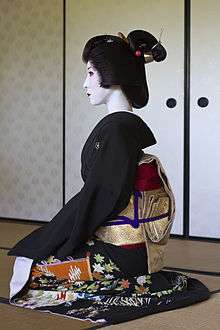Shimada (hairstyle)

The Shimada (島田) is a women's hairstyle in Japan, similar to a chignon. Its modern usage is mainly limited to geisha (wearing it as a wig), but during the Edo period it was also worn by ordinary women, and especially by girls in their late teens. Generally the hair is gathered together at the crown of the head and a small portion of the bun is sectioned off to point outward.
Variations
There are four major types of the Shimada:
- Taka Shimada, a high chignon (a kind of knot of hair), usually worn by young, single women
- Tsubushi Shimada, a more flattened chignon generally worn by older women
- Uiwata, a chignon that is usually bound up with a piece of color cotton crepe
- Momoware, a style that ends up looking like a divided peach, typically worn by maiko
In the Edo period
_-_from_the_series_'Twelve_types_of_women's_handicraft_(Fujin_tewaza_juniko)'_-_Google_Art_Project.jpg)
These hairstyles developed in the Edo period, when the preference among women for long, flowing hairstyles gave way to elaborate, upswept styles with buns at the back of the neck. The trend started among courtesans and kabuki actors, but soon spread to fashionable merchants' wives and then became a general fashion trend.[1]
_Tomimoto_Toyohisa_reading_a_letter_(Rijksmuseum%2C_cropped).jpg)
To create these coiffures, the hair was usually divided into six sections – the two sides, the front, the back, the nape of the neck, and the center – all of which were eventually brought together in the center. The center section was secured with string, and frames, pins, and combs were inserted as required to hold the style in place.[1]
An elaborate version of the Shimada that became popular in the mid–Edo period (18th century) was called the Tōrōbin Shimada. It featured wide wings at the side and is often seen in ukiyo-e prints by artists such as Utamaro. The name means "Lantern Shimada", and is said to refer to the way that the background can be seen through the wings on the sides, like scenery seen through a tōrō lantern.[2]
Notes
- 1 2 Sherrow, Victoria (2006). Encyclopedia of Hair: A Cultural History. Greenwood Publishing Group. p. 222. ISBN 9780313331459.
- ↑ "Description of Japanese Hairstyles (日本髪の解説)" (in Japanese). Retrieved 2014-10-06.
References
- Asano, Tamaki (1990). "Women's Hairdressing". In Dr. Junichi Saga. Memories of Silk and Straw: a Self-Portrait of Small-Town Japan. Translated by Garry O. Evans (1st paperback ed.). Tokyo: Kodansha International. pp. 150–154. ISBN 0-87011-988-5.
External links
| Wikimedia Commons has media related to Traditional hair and makeup of Japan. |
- Illustration of how to make a Tōrōbin Shimada (in Japanese)